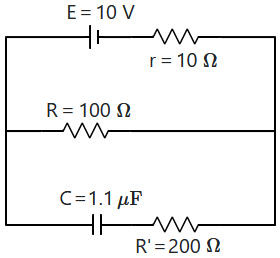Select Chapter Topics:
A battery of \(6\) V is connected to the circuit as shown below. The current \(i\) drawn from the battery is:

1. \(1\) A
2. \(2\) A
3. \(\frac{6}{11}~\text{A}\)
4. \(\frac{4}{3}~\text{A}\)
Subtopic: Wheatstone Bridge |
87%
From NCERT
JEE
Please attempt this question first.
Hints
Please attempt this question first.
Two sources of equal emfs are connected in series. This combination is connected to an external resistance \(R\). The internal resistances of the two sources are \(r_1\) and \(r_2\) \((r_1>r_2)\). If the potential difference across the source of internal resistance \(r_1\) is zero then the value of \(R\) will be:
1. \(r_{1}-r_{2} \)
2. \(\dfrac{{r}_{1} r_{2}}{{r}_{1}+r_{2}} \)
3. \(\dfrac{{r}_{1}+r_{2}}{2} \)
4. \({r}_{2}-{r}_{1}\)
1. \(r_{1}-r_{2} \)
2. \(\dfrac{{r}_{1} r_{2}}{{r}_{1}+r_{2}} \)
3. \(\dfrac{{r}_{1}+r_{2}}{2} \)
4. \({r}_{2}-{r}_{1}\)
Subtopic: EMF & Terminal Voltage |
68%
From NCERT
Please attempt this question first.
Hints
Please attempt this question first.
In a meter bridge experiment for measuring unknown resistance \(S\), the null point is obtained at a distance \(30\) cm from the left side as shown at point \(D\). If \(R\) is \(5.6~\text{k} \Omega\), then the value of unknown resistance \(S\) will be:

1. \(24~\Omega\)
2. \(2400~\Omega\)
3. \(120~\Omega\)
4. \(3600~\Omega\)

1. \(24~\Omega\)
2. \(2400~\Omega\)
3. \(120~\Omega\)
4. \(3600~\Omega\)
Subtopic: Meter Bridge |
89%
From NCERT
JEE
Please attempt this question first.
Hints
Please attempt this question first.
A \(1\) m long copper wire carries a current of \(1\) A. If the cross-section of the wire is \(2.0\) mm2 and the resistivity of copper is
\(1.7\times10^{-8}~\Omega\) m, the force experienced by a moving electron in the wire is:
(charge on electron = \(1.6\times 10^{-19}\) C)
1. \(112\times 10^{-23}\) N
2. \(240\times10^{-23}\) N
3. \(136\times 10^{-23}\) N
4. \(321\times 10^{-23}\) N
\(1.7\times10^{-8}~\Omega\) m, the force experienced by a moving electron in the wire is:
(charge on electron = \(1.6\times 10^{-19}\) C)
1. \(112\times 10^{-23}\) N
2. \(240\times10^{-23}\) N
3. \(136\times 10^{-23}\) N
4. \(321\times 10^{-23}\) N
Subtopic: Current & Current Density |
73%
From NCERT
JEE
Please attempt this question first.
Hints
Please attempt this question first.
In the given figure of the meter bridge experiment, the balancing length \(AC\) corresponding to the null deflection of the galvanometer is \(40\) cm. The balancing length, if the radius of the wire \(AB\) is doubled, will be:

1. \(20\) cm
2. \(30\) cm
3. \(40\) cm
4. \(60\) cm

1. \(20\) cm
2. \(30\) cm
3. \(40\) cm
4. \(60\) cm
Subtopic: Meter Bridge |
75%
From NCERT
JEE
Please attempt this question first.
Hints
Please attempt this question first.
As shown in the figure, in a steady state, the charge stored in the capacitor is \(x \times 10^{-6}\) C. The value of \(x \) is:

1. 20
2. 10
3. 30
4. 40

1. 20
2. 10
3. 30
4. 40
73%
From NCERT
JEE
Please attempt this question first.
Hints
Please attempt this question first.
A wire of resistance \(R_1\) is drawn out so that its length is increased by twice its original length. The ratio of new resistance to original resistance is:
1. \(9:1\)
2. \(1:9\)
3. \(4:1\)
4. \(3:1\)
1. \(9:1\)
2. \(1:9\)
3. \(4:1\)
4. \(3:1\)
Subtopic: Derivation of Ohm's Law |
From NCERT
JEE
Please attempt this question first.
Hints
Please attempt this question first.
Two coils require \(20\) minutes and \(60\) minutes respectively to produce the same amount of heat energy when connected separately to the same source. If they are connected in parallel arrangement to the same source; the time required to produce the same amount of heat by the combination of coils will be:
1. \(10\) min
2. \(30\) min
3. \(15\) min
4. \(25\) min
1. \(10\) min
2. \(30\) min
3. \(15\) min
4. \(25\) min
Subtopic: Heating Effects of Current |
79%
From NCERT
JEE
Please attempt this question first.
Hints
Please attempt this question first.
The variation of applied potential, \(V\) and the current, \(I\) flowing through a given wire is shown in the figure. The length of the wire is \(31.4~\text{cm}.\) The diameter of the wire is measured as \(2.4\) cm. The resistivity of the given wire is measured as \(x\times 10^{-3}~\Omega \text-\text{cm}.\) The value of \(x\) is:
(take \(\pi= 3.14\))

1. \(146\)
2. \(142\)
3. \(140\)
4. \(144\)
(take \(\pi= 3.14\))

1. \(146\)
2. \(142\)
3. \(140\)
4. \(144\)
Subtopic: Derivation of Ohm's Law |
75%
From NCERT
JEE
Please attempt this question first.
Hints
Please attempt this question first.
For the network shown below, the value \(V_B-V_A\) is:

1. \(10\) V
2. \(15\) V
3. \(20\) V
4. \(25\) V

1. \(10\) V
2. \(15\) V
3. \(20\) V
4. \(25\) V
Subtopic: Kirchoff's Voltage Law |
68%
From NCERT
JEE
Please attempt this question first.
Hints
Please attempt this question first.






